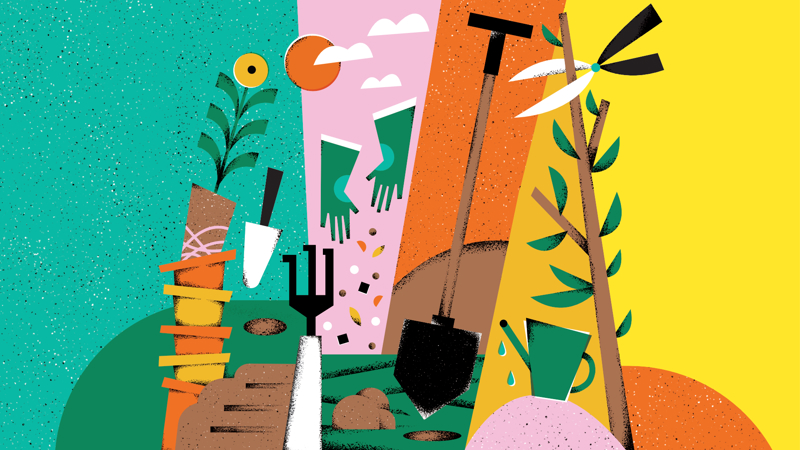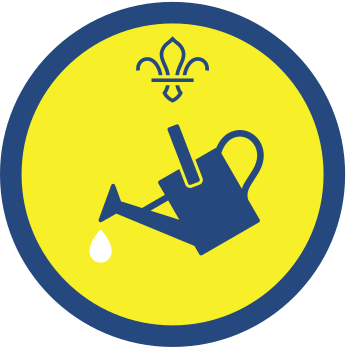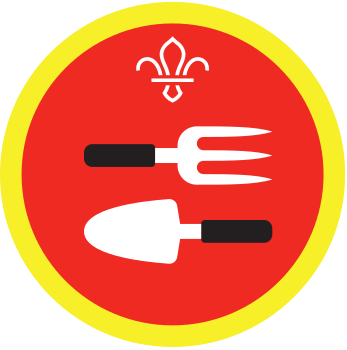
Identify different garden tools
You’ll need
- Pens or pencils
- A4 paper
- Plant pots
- Tree, plant or wildlife ID cards (optional)
Before you begin
- Use the safety checklist to help you plan and risk assess your activity. Take a look at our guidance to help you carry out your risk assessment, including examples.
- Make sure all young people and adults involved in the activity know how to take part safely.
- Make sure you’ll have enough adult helpers. You may need some parents and carers to help if you’re short on helpers.
Planning and setting up this activity
- On separate pieces of paper, write out different gardening tasks and tools. You may need more than one copy of each tool, as they may be used in different tasks. We’ve included some suggestions on this page. You may wish to use pictures of the tools instead or alongside the words.
- Set up a row of plant pots and put a task in each plant pot.
- Hide the names of tools around your meeting place.
Running this activity
- Gather everyone together and ask everyone why we use tools in gardening. Does anyone know what sort of tools there are and how they help us? Has anyone used any tools before?
- If you’re able to, you may wish to bring in the tools to show everyone. Always make sure to handle them safely, use any safety locks or covers, and always having adult supervision.
- Ask everyone to get into teams. Each team should take a plant pot with a task in it. Together, they should search for the tools they need for their gardening task.
- When the teams have found all the tools they need, gather everyone back together.
- Ask each team to write down the name of each tool on a separate piece of paper.
- Explain that you’ll read out the description and they have to hold up the name of the tool that it matches. You could talk about each tool and how to keep safe when using it. The descriptions are:
- Gardening gloves: These essential for gardening or outdoor taks. They help to keep our hands clean and give us better grip. They also help us to avoid cuts and grazes when using tools or working with spiky plants.
- Hand trowels: These are must-have tools. Almost like a very small shovel, you can use them to dig, turn the earth, or pull up stubborn weeds. You can also use them to transfer soil into pots when planting seedlings and bulbs.
- Secateurs: These are used for cutting and trimming thin branches and stems, and also to harvest small fruits and vegetables. Just like scissors, an adult should teach everyone how to use them safely and supervise throughout.
- Hand forks: These are used to turn, lift and loosen hard dirt and soil. It’s especially useful when weeding your garden as it helps to loosen weeds.
- Spades: These are used to dig deep holes, remove large weeds, move compost and cut through roots when digging.
- Watering cans: We use these to water our flowers and plants. They can get very heavy when filled with water, so only fill with as much water as you’re comfortable carrying.
- Ask everyone how they think we could stay safe while using each of these tools. We’ve included some tips on this page.
- Now everyone’s identified the different tools and what they’re used for, it’s time to think about the green spaces in your local community and what could be done maintain or improve the area.
- Ask everyone to think of an area and see what they can think could be improved. Everyone should remember to think about the things that shouldn’t be touched too, such as good plants or existing wildlife habitats that they shouldn’t disturb. Things like fallen trees, logs and leaves on the floor are all also very good for habitats.
- Ask how you could use some of these different tools to complete tasks to maintain the area and encourage more plants or wildlife to thrive. For example, cutting back plants.
|
Gardening tasks |
Tools needed |
|
Dig a hole and plant a tree in it |
|
|
Prune a hedge |
|
|
Plant some seeds |
|
|
Weed the garden |
|
|
Harvest fruits and vegetables |
|
|
Water the garden |
|
- wearing sturdy footwear or safety shoes/boots with protective toecaps
- using a spade or hand trowel for digging instead of your fingers or hands.
- avoid loose fitting, baggy clothing that could become snagged
- wearing a dust mask when digging or potting
- putting on safety goggles or visors when cutting and trimming with secateurs, as branches or twigs may fly off when cut
- keeping your hand and wrist in a straight line when you use hand tools
- wearing earmuffs or earplugs when using noisy equipment
- following with the manufacturer’s instructions on proper use of the equipment
- always using safety guards or safety devices on equipment
- check your equipment regularly to make sure it’s in good working order
- storing equipment in a safe place when not in use, out of the reach of young people, and not leaving it out or on the ground
- rotating your gardening tasks and taking lots of breaks to avoid repetitive movements or strain
Reflection
This activity was about developing practical gardening knowledge and knowing which tools are which. Why might it be useful to know which tool to use for a task in the garden or outdoors? How can tools help people to complete gardening tasks? Why’s it important to understand that tools can be dangerous? People could talk about why they need to handle tools safely, and what handling them safely means.
Safety
All activities must be safely managed. You must complete a thorough risk assessment and take appropriate steps to reduce risk. Use the safety checklist to help you plan and risk assess your activity. Always get approval for the activity, and have suitable supervision and an InTouch process.
- Outdoor activities
You must have permission to use the location. Always check the weather forecast, and inform parents and carers of any change in venue.
- Animals and insects
Be aware of the risks before interacting with animals. Be aware of anyone with allergies, and make alternative arrangements for them.
- Gardening and nature
Everyone must wash their hands after the activity has finished. Wear gloves if needed. Explain how to safely use equipment and set clear boundaries so everyone knows what’s allowed.
Make it accessible
All Scout activities should be inclusive and accessible.
If you enjoyed this activity, why not take it one step further and plan a community gardening project?



